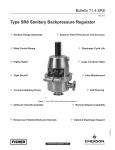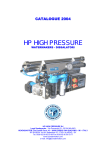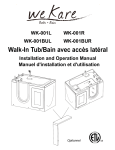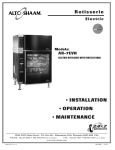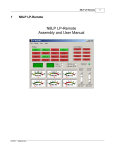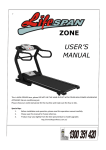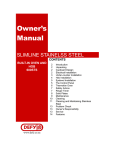Download Amana IC6 Owner`s manual
Transcript
® IC6 Top and Bottom Freezer Refrigerator Ice Maker Kit Operating and Installation Instructions Keep these instructions for future reference. Be sure this manual stays with refrigerator Part No. 10527053 Printed in U.S.A. 11/00 © 2000 Amana Appliances Amana, Iowa 52204 IMPORTANT SAFETY INSTRUCTIONS Introduction ! ! CAUTION To avoid risk of personal injury or property damage, do not place fingers or hands on or around the automatic icemaking mechanism while the refrigerator is plugged in. RECOGNIZE THIS SYMBOL AS A SAFETY PRECAUTION Read entire manual before installing kit. All necessary tools and materials must be available prior to installation. Verify all listed parts are included in kit. If parts are missing, contact source from whom kit was purchased. • If unable to solve a problem during installation, contact an authorized Amana technician. Locate a factory Service Center or independent authorized technician by calling 1-800-628-5782 inside U.S.A. and 1-319-622-5511 outside U.S.A. Service is at owner’s expense. SAVE THESE INSTRUCTIONS Safety Instructions ! WARNING To avoid electrical shock which can cause severe personal injury or death, unplug power cord or open household circuit breaker to refrigerator before installing kit. After installing kit, reconnect power. ! CAUTION To avoid property damage, observe the following: REPLACE ORIGINAL ICE STORAGE BUCKET WITH ONE FROM KIT to avoid spilling ice cubes. • Confirm water pressure to water valve is at least 20 pounds per square inch. • Start nuts by hand to avoid cross threading. Finish tightening nuts using a wrench. Do not overtighten. • Check carefully for water leaks prior to returning refrigerator to normal location and 24 hours after connection. 2 HOW THE ICEMAKER WORKS 1. Water fills the empty cube mold when the freezer has cooled to freezing temperature. Cold air is forced directly over the mold. 3. The feeler arm senses when the bin is full and signals the icemaker to stop ejecting more cubes. However, the mold has been refilled and cubes frozen so the new supply is ready when needed. As soon as ice is removed from the bin, the feeler arm signals that more is needed. Icemaker resumes operation by ejecting ready-and-waiting frozen cubes. Feeler arm Ice storage bin 2. When frozen, the cubes are moved up and out of the mold. The sweeper arm ejects them into the ice storage bin below. Sweeper arm Ice Ice storage bin 3 HOW TO USE YOUR ICEMAKER 7. Ice cubes that have been in the ice storage bin for a considerable length of time may pick up off-flavor tastes, stick together, and gradually become smaller. We suggest that these cubes be thrown away. 1. To start the Icemaker, lower the feeler arm to the ON (down) position. Make sure the ice storage bin is below the icemaker and pushed back as far as possible. 8. The ice storage bin should be cleaned occasionally in warm water. Rinse and wipe dry. Be sure to put the icemaker feeler arm in the STOP (up) position when cleaning the bin. 9. Keep the cubes distributed levelly and the bin can reach its maximum cube capacity. If the cubes should build up in one area of the ice storage bin after being ejected from the mold, just level them out with your hand. Arm up — stops operation Arm down — icemaker will operate 2. When the Icemaker is first connected or after any extended period of non-use, you should discard the first few batches of cubes. Use ice regularly to maintain the best quality. 3. The feeler arm must be free to operate upward and outward over the top of the ice storage bin during each ice-delivery cycle. Make sure packages in the freezer compartment do not block its movement. 4. Raise the feeler arm to the STOP (up) position when: a. Ice storage bin is to be removed for extended period of time. b. Refrigerator is not to be used for an extended time, such as vacations. Also, turn off the water supply to the Icemaker in this instance. c. Water supply is to be shut off for several hours. 5. During operation, you may hear certain sounds, such as the hum of the motor, movement of the cube ejector, humming or clicking of the water valve, and rattling of ice as it falls into the bin. These sounds are normal. 6. The Icemaker ejects cubes in groups and it is normal for several cubes to be joined together. 4 IC-6 ICE MAKER KIT INSTALLATION INSTRUCTIONS • • • Read these instructions all the way through before starting. IMPORTANT: OBSERVE ALL GOVERNING CODES AND ORDINANCES. Installer—Be sure to leave these instructions with the Consumer. ! CAUTION IMPORTANT • Before connecting ice maker, contact a plumber to connect copper tubing to household plumbing. A ¼" (6mm) O.D. copper tubing must be used. • Length of copper tubing must reach from water supply connection; in addition, 8 ft. should be added to create a service loop behind the refrigerator. The tubing should be soft and ends should be free of burrs. • Do not use a self piercing saddle valve! These valves will get clogged with sediment over time restricting the flow of water to the refrigerator. • Water pressure to water valve must be at least 20 pounds per square inch to assure proper performance. For your safety, unplug the refrigerator from its electrical outlet to eliminate danger of electric shock during installation. TOOLS REQUIRED • 6” Blade-type screwdriver • ¼" hex socket and driver • Adjustable wrench/or • ½" open-end wrench • 3/8" open-end wrench • Needle nose pliers • Masking tape • Protective gloves • Utility knife • Bucket • Towel • Tape measure CONTENTS OF IC-6 Compression nut “P” clamp Ice maker wire harness Button plugs Water tube Sleeve 5/8" Ice maker mounting screws Flexible plastic tubing Plastic clip Stainless steel clip Ice storage bucket Water valve assembly Wire harness assembly 5 Ice maker PREPARE THE FREEZER COMPARTMENT 4. INSTALL WATER FILL TUBE THROUGH THE BACK OF THE REFRIGERATOR. a. Remove the cover for the water tube inlet hole on the back of the refrigerator near the bottom. Use a flat-bladed screwdriver blade covered with masking tape to prevent scratching the refrigerator. 1. REMOVE ALL BASKETS AND SHELVES FROM THE FREEZER. 2. REMOVE THE ICE SERVICE RACK (some models) On some models, an ice service rack is mounted on two screws in the freezer side wall. If your refrigerator has an ice service rack: a. Remove ice trays and storage bin. b. Remove the two screws and discard screws and washers. Masking tape Cover for the water tube inlet hole on the back of the refrigerator Screws Washer b. After removing the cover, use the screwdriver to pierce the interior sealing tape that covers the hole for the water fill tube inlet. Clear a path for the water fill tube. Ice service rack Sealing tape (remove) 3. REMOVE ELECTRICAL AND WATER CONNECTION COVER. Back wall inside freezer Remove screw that holds the cover in place. Discard the screw and cover. Water tube inlet hole Back of the refrigerator Electrical connection Electrical plug and water connection cover Screw 6 c. To prevent the styrofoam insulation beads from entering the water fill tube during installation, temporarily cover the end of the tube with masking tape. Push the water fill tube through the hole. d. From the inside of the freezer, pull the water fill tube through the hole in the back wall. Be sure to remove the masking tape from the end of the water fill tube to allow water to flow into the icemaker. Water fill tube Back wall inside freezer Water tube inlet hole Masking tape Back of the refrigerator Electrical connection e. From the back, push gently on the water fill tube while twisting it slightly, until the flange is firmly seated on the hole on the back of the refrigerator. Make sure the water fill tube is completely seated. Flange Seated water fill tube Water fill tube 7 INSTALL THE WATER VALVE FOR 30" AND 33" WIDE BOTTOM FREEZERS AND ALL TOP FREEZERS e. Attach the water valve to the lower rail using the hex screws removed from the mounting plate. This will assure that the water valve is electrically grounded. INSTALL THE WATER VALVE. (for 36" wide bottom freezer models, see “Install Water Valve for 36" Wide Bottom Freezer Models) a. Remove the vertical tube cover from the back of the refrigerator (for top freezer models, remove only lower section of cover) ¼" plastic tubing ¼"plastic tubing Wire and tube cover f. Plug the water valve wire connector into the terminal board at the points on the bottom right position, marked “1” and “2” across from “A” and “B”. b. To access the water valve opening, cut along the outline in the fiberboard cover using a utility knife. Remove the fiberboard. c. Use a ¼" hex nut driver to remove the two lower screws from the back mounting plate and discard the mounting plate. Terminal board Water valve wire connector Back mounting plate must be removed g. Re-install the vertical wire and tube cover. To avoid pinching wires, carefully tuck the wires inside the cover. Secure the cover by reusing all the original screws. h. Secure the ¼" flexible plastic tubing to the rear wall of the refrigerator cabinet using the plastic stick-on clamp. d. Thread the water valve wires through the rectangular openings, taking care not to bend any existing tubes. Water valve wire connector Water valve wires Wire and tube cover ¼" flexible plastic tubing ¼" plastic tubing Plastic stick-on clamp NOTE: The P-clamp is used to secure the ¼" flexible copper tubing at the back horizontal cover, using the existing cover screw. (See Water Line Installation Instructions.) Water valve 8 INSTALL THE WATER VALVE FOR 36" WIDE BOTTOM FREEZER MODELS d. Insert harness and valve through opening in back cover. Mount valve to back cover and mounting plate with 3 hex head screws retained from cover plate removal. FOR 36" WIDE BOTTOM FREEZER MODELS a. Remove and retain screws from water valve cover plate using a ¼" hex socket and driver. Mounting plate Water valve cover plate Wire harness Back cover Water valve assembly b. Remove wire harness attached to cover plate by squeezing wire tie with pliers and pushing tie through hole in plate. Pull end of wire harness through opening in back cover. Discard plate. Refrigerator harness c. Remove wire harness from water valve assembly and discard wire harness. Plug water valve assembly into refrigerator harness. 9 INSTALL THE ICE MAKER The water fill tube fits under the stainelss steel clip on the water cup. The water fill tube must not be kinked. It should extend approximately ½" into the water cup and must not become easily dislodged. f. Screw in the remaining icemaker mounting screw. Tighten all three screws. 4. HANG THE ICEMAKER ON FREEZER WALL a. Slip the stainless steel clip over the wall of the water cup. Stainless steel clip 5. LIFT THE ICEMAKER FEELER ARM TO THE STOP (UP) POSITION. The icemaker should feel secure when you lift the arm. Leave the feeler arm in the STOP (up) position until the refrigerator is connected to the water supply to prevent it from operating before the water supply connection is complete. b1.Top mount only: Cover the tip of a knife blade with masking tape to protect the inside of the freezer. Carefully pry out and discard the white plastic buttons from the left side of the freezer. b2.Bottom mount only: Unscrew remaining phillips head screws from left side of freezer. Feeler arm Arm up— stops operation Arm down— icemaker will operate c. Screw two 5/8" icemaker mounting screws in the top holes. Leave the head out approximately 3/8" for the slot in the icemaker hanger to slip over the screws. d. Hold the icemaker in position inside the freezer. Insert the wire harness plug into the connector. Verify plug orientation from freezer connector. Plug fits only one way. Using a rocking motion, until the locking fingers on the sides of the plug snap into place. Place screws in top screw holes Hangers 6. REPLACE BASKETS AND SHELVES AND PLACE ICE STORAGE BIN ON FREEZER SHELF. • Replace freezer basket(s) and shelve(s). • Move the ice storage bin into place directly under the icemaker. Adjust shelves if necessary. • NOTE: Check again to make sure the icemaker power cord is fully inserted into its outlet. • Check again to make sure the icemaker feeler arm is in the STOP (up) position. Water fill tube Wire harness connection Feeler arm in STOP (up) position Water cup e. Slip the icemaker hanger over the mounting screws while easing the icemaker water cup toward the end of the water fill tube. The icemaker installation is now complete. Refer to the following instructions for connecting the icemaker to the home water supply. 10 CONNECT REFRIGERATOR TO WATER SUPPLY g. Secure the ¼" flexible copper tubing with the P-clamp at the back horizontal cover, using the existing cover screw. Create a service loop out of additional 8' of copper tubing. 1. CONNECT COPPER TUBING TO REFRIGERATOR. Before making connection to the refrigerator, be sure refrigerator power cord is not plugged into wall outlet. a. Turn water on and flush out the water supply tubing, making certain that all foreign matter is removed from the line. b. Shut the water off after about 1 quart of water has been flushed through the tubing. Use bucket to catch water. NOTE: Some localities may have sand or other foreign matter present in the water supply in such quantities that they may, in time, collect in the screen of the water valve attached to the back of the refrigerator and tend to reduce the water flow to the icemaker. Where such conditions exist, we recommend that an additional filter or strainer be installed in the line near the refrigerator. If a screen type strainer is used, it should be 80 mesh or finer. c. If using existing flared tubing, cut off the flared end of the copper tubing and remove the brass sleeve and nut from the tubing. d. Remove the plastic cap from the water valve inlet port. e. Connect copper tubing to the water valve. Place the ¼" compression nut and brass sleeve onto the end of the tubing as shown below. f. Insert the end of the copper tubing into the water valve as far as possible. While holding the tubing, tighten the fitting, then pull on the tube to check for a secure connection. DO NOT OVER TIGHTEN. ¼" flexible copper tubing "P" clamp 2. TURN ON WATER AND CHECK ALL JOINTS FOR LEAKS. Tighten fittings if required to stop leaks. 3. PLUG REFRIGERATOR POWER CORD INTO APPROPRIATE ELECTRICAL OUTLET. 4. MOVE THE REFRIGERATOR BACK TO THE WALL. Arrange the coil of copper tubing so that it does not vibrate against the back of the refrigerator or against the wall. Make sure the copper tubing does not get kinked. "P" clamp NOTE: • Allow 24–48 hours after installation before first harvest of ice. • The first two batches of cubes should be thrown away, so that remaining impurities in the water line will be flushed out. • Check for water leaks 24 hours after installation. Copper tubing Brass sleeve W ater valve inlet port Brass nut ! CAUTION To avoid property damage, all covers must be in place before plugging unit in. 11 TROUBLE SHOOTING GUIDE TOPIC POSSIBLE CAUSE SOLUTION Ice maker arm is not in correct position Confirm ice maker arm is down. See Automatic Ice Maker section in your owner’s manual for details. Electrical power cord may not be plugged in Make sure plug from power cord fits tightly into wall outlet. The icemaker is not getting the necessary supply of water. Make sure the water supply is connected and turned on. Check for kinks in the ¼" copper tubing. Remove kinks or replace tubing if there are kinks. Freezer temperature is too low See the controls section in your owner’s manual for assistance on how to adjust your controls. Freezer must be between 0 to 2°F (-18 to -17°C) to produce ice. The cubes are too small. The shutoff valve connecting the refrigerator to the home water line may be clogged. Unclog it. Small or hollow cubes Water utilizing devices in use elsewhere in house Avoid operating device such as dishwasher, washing m machine or shower. Ice cubes have odor/taste Ice stored for an extended period may absorb odors which affect their taste. Discard old cubes. Use icemaker regularly. Ice storage bin needs to be emptied and washed. Empty and wash ice storage bin. Unsealed packages in the refirgerator ad/or freezer compartments may be transmitting odor/taste to ice cubes. Check seals on packages in freezer. The interior of the refrigerator needs cleaning. See Odor Removal instructions in Care and Cleaning Section. Ice maker arm is not in correct position Confirm ice maker arm is down. See Automatic Ice Maker section in your owner’s manual for details. Household water supply is not reaching water valve. Check water connection procedure in your Installation Instructions. Copper or plastic tubing has kinks. Turn off water supply and remove kinks. If kinks cannot be removed, replace tubing. Amana recommends using a saddle valve. Contact 1-800-843-0304 or an Amana dealer for availability. Do not use self-piercing valve. Amana is not responsible for property damage due to improper installation or water connection. Water pressure is too low. Water pressure must be between 20 to 100 pounds per square inch to function properly. A minimum pressure of 35 pounds per square inch is recommended for units with water filters. Freezer temperature is too low. See the controls section in your owner’s manual for assistance on how to adjust your controls. Freezer must be between 0 to 2°F (-18 to -17°C) to produce ice. Improper water valve was installed. Check water connection procedure in your Installation Instructions. Self-piercing and 3/16” saddle valves cause low water pressure and may clog the line over time. Amana is not responsible for property damage due to improper installation or water connection. Ice maker wiring harness is not completely inserted into proper holes. Confirm ice maker wiring harness is completely inserted in proper holes. Electrical connection to water valve coil and connector block may be loose. Check electrical connections to water valve coil and connector block on refrigerator cabinet. Ice maker appears to have stopped operating Icemaker is not producing ice 12 TOPIC POSSIBLE CAUSE SOLUTION Icemaker is not producing ice (some models) (continued from previous page) Freezer section not operating at proper temperature. Confirm that freezer section is operating at proper temperature. Adjust accordingly. Ice maker is not producing enough ice or ice is malformed. Ice maker has just recently been installed or a large amount of ice has just been used. Wait 24 hours for ice production to begin and for ice to restock after emptied. Water pressure is too low. Low water pressure can cause valve to leak. Water pressure must be between 20 to 100 pounds per square inch to function properly. A minimum pressure of 35 pounds per square inch is recommended for units with water filters. Freezer temperature is too low. See the controls section in your owner’s manual for assistance on how to adjust your controls. Freezer must be between 0 to 2°F (-18 to -17°C) to produce ice. Ice cubes stick together or “shrink”. Ice cubes have not been emptied. Empty ice cube bucket or trays more frequently. If used infrequently, ice cubes may stick together or shrink. Ice forms in inlet tube to ice maker (some models). Water pressure is too low. Check water pressure. Low water pressure will cause valve to leak. Self-piercing valves cause low water pressure. Amana recommends using a saddle valve. Contact 1-800-843-0304 or an Amana dealer for availability. Do not use self-piercing valve. Amana is not responsible for property damage due to improper installation or water connection. Freezer temperature is too high See the controls section in your owner’s manual for assistance on how to adjust your controls. Freezer is recommended to be between 0 and 2°F (-18 to -17°C). Plastic tubing was used to complete water connection. Amana recommends using copper tubing for installation. Plastic is less durable and can cause leakage. Amana is not responsible for property damage due to imporper installation or water connection. Water pressure is too low. Low water pressure can cause valve to leak. Water pressure must be between 20 to 100 pounds per square inch to function properly. A minimum pressure of 35 pounds per square inch is recommended for units with water filters. Improper water valve was installed Check water connection procedure in your Installation instructions. Self-piercing and 3/16” saddle valves cause low water pressure and may clog the line over time. Amana is not responsible for property damage due to improper installation or water connection. Unit is leaking water For more information on this and other Amana products, visit our Web site www.amana.com or call Consumer Affairs Department at 1-800-843-0304 13 WARRANTY Ice Maker Full One Year Warranty First Year Amana Appliances will repair or replace, free of charge, any part which is defective due to workmanship or materials. Owner’s Responsibilities Warranty Limitations • Provide proof of purchase (sales receipt). • Begins at date of original purchase. • Provide normal care and maintenance. • Applies to product used within the United Replace owner replaceable items where States or in Canada if product has Canadian directions appear in Owner’s Manual and Standards Association listing when shipped Installation Instruction. from the factory. • Make product reasonably accessible for • Service must be performed by an authorized service. Amana® technician. • Pay for premium service costs for service outside technician’s normal business hours. Warranty Is Void If • Pay for service calls related to product • Product is used on a commercial, rental or installation or customer education. leased basis. • Product has defect or damage due to an In no event shall Amana Appliances be liable accident, fire, flood, connection to an improper for incidental or consequential damages.* electrical or water supply, lightning, product alteration, shipping and handling, or other *This warranty gives you specific legal rights conditions beyond the control of Amana. and you may have others which vary from state • Product is improperly installed or used. to state. For example, some states do not allow the exclusion or limitation of incidental or consequential damages so this exclusion may not apply to you. 14 Part No. 10527053 Printed in U.S.A. 11/00 © 2000 Amana Appliances Amana, Iowa 52204

















